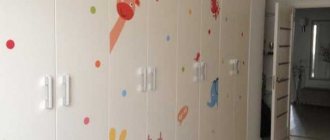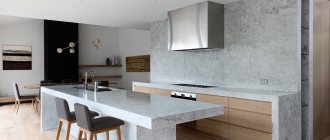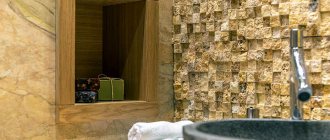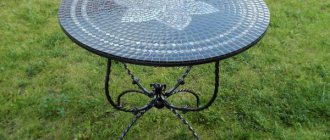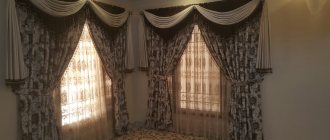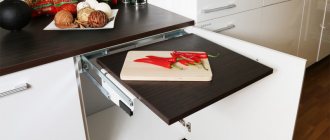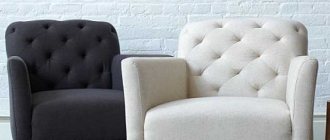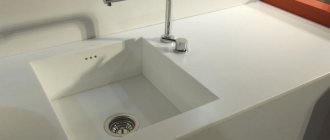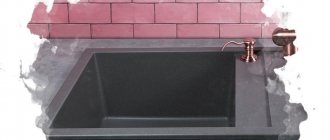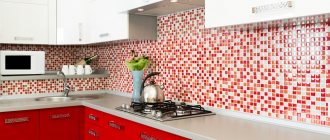Hello! The topic of our conversation today will be a wood-look countertop for the kitchen. But other materials that can be used in the manufacture of such a structure will also be considered.
Tabletops are used as work surfaces. This is where we cut something, slice it, prepare food, lay out the washed dishes, knead the dough and carry out a whole range of other manipulations.
It is important to understand that constant and various loads act on the surface, including mechanical, temperature and water, let’s call them that. When organizing a kitchen space, special attention is deservedly paid to such components as the apron (wall panels along the kitchen work area) and the countertop. Before you buy and determine which design to use in your kitchen, you need to study the available materials.
Materials used
If you look at the photo, each imitation wood countertop looks great. And real wood is also not excluded from the list, despite its apparent shortcomings.
[adv1]
Since there are a huge number of furniture and construction stores in Moscow, St. Petersburg, the cities of Ufa, Kyiv, Volgograd and others, there should be no problems with the assortment. Just look at the catalog and you will see a wide variety of models that imitate wood and more.
Some buy only material with an area of about 3 m2, and with their own hands they cut out the tabletop, areas for the sink and create kitchen furniture from scratch.
In such a matter as choosing a countertop, I recommend paying the main attention to the material used. Some of them perfectly imitate wood, while others have their own original texture, which provides certain advantages in the kitchen. And it doesn’t matter whether it will be white, or whether the base will use a gloss or matte surface. This is secondary. We start with choosing the material.
In total, the following options are offered:
[adv2]
- solid wood;
- MDF;
- laminated chipboard;
- stone countertop;
- made of plastic;
- stone;
- steel.
The assortment is huge. And then you yourself understand that plastic countertops, products based on chipboard and MDF can imitate wood. The rest of the materials are not.
I propose to discuss each option separately. Moreover, we will do this in such a way that I will tell you about the main features of the material, and also name its strengths and weaknesses. Based on this, you can each draw appropriate conclusions for yourself.
Where are wood-look countertops used?
A wood-look countertop is a universal element of any interior . Unlike natural wood, it is inexpensive and attracts buyers with its affordability and beauty. It is used in spacious and small kitchens as a work surface, bar counter or dining table. They decorate it with decorated elements - carvings, sides, plastic inserts.
This surface complements modular and custom-made furniture, is practical and easy to clean . It will harmoniously fit into the interior of a dacha or country house, studio apartment or office kitchen.
What to consider when choosing
The main criteria are size and shape . For a corner set, several surfaces are selected, which together form a right angle. For linear - rectangular. It is recommended to measure the dimensions of the kitchen in advance - it is important that the countertop fits perfectly.
Color and design play a role . For small kitchens, choose light options without decoration, for example, white or light yellow, imitating solid birch. Light shades visually enlarge the room. If the kitchen is spacious, a surface that imitates a natural oak countertop will do. Dark oak color will give the kitchen nobility and elegance.
Pay attention to the manufacturing company . It is recommended to trust trusted manufacturers with a good reputation, study their website and product catalog, and read reviews.
Reference. Small furniture manufacturers have lower prices than well-known brands.
MDF
It is also a finely dispersed fraction. The basis is a slab material, on top of which a high-strength laminate is applied, complemented by a protective coating. To extend service life, a layer of plastic is placed on top. It is he who can imitate wood and other materials.
The factor of using plastic leads to an increase in price. But the surface becomes more moisture-resistant, durable and visually attractive.
The advantages include:
- affordable price;
- environmental friendliness;
- a wide range of;
- the ability to imitate wood and more;
- protection against fungus and other microorganisms.
But don't forget about the downsides. Here they are as follows:
- low level of fire safety;
- poor resistance to mechanical damage;
- limited service life;
- possibility of bloating.
Only if the material has undergone special processing can MDF be used in the kitchen as a countertop. Otherwise, the product will not last long and will quickly become unusable.
Chipboard
Also, countertops are actively produced on the basis of particle boards. The top is covered with plastic, and before that with kraft paper with synthetic resins. Everything ends with a decorative layer, where one of the options is imitation wood.
See also:
Adjustable canopy for a closet: main selection criteria
The advantages are:
- high-quality and realistic imitation of wood and other materials;
- low price;
- fast production;
- huge assortment;
- simple processing;
- easy installation;
- Possibility of quick replacement when worn out.
But be careful and careful when choosing chipboard. Even fairly high-quality products have a number of disadvantages.
The disadvantages are as follows:
- traces of drinks and ordinary water remain;
- swelling occurs from contact with moisture;
- not particularly heat resistant;
- fire hazardous;
- period no more than 10 years;
- impregnations that are potentially harmful to health.
Really cheap, but too many resulting shortcomings. Not the best option for those who want a high-quality, functional and durable countertop. Even moisture-resistant impregnation does not help much, as the reviews of the owners clearly indicate.
Array
See also:
How a memory foam mattress works, pros and cons, which one to choose
When it comes to countertops, species such as oak, walnut, ash, maple, cherry and bamboo are suitable for such purposes. Wood does not like moisture or temperature changes and actively absorbs moisture.
To get rid of imperfections, wood is treated, impregnated and protected with special coatings. Even after this, you should not install it near the dishwasher or taps.
Strengths:
- naturalness;
- no need to imitate wood;
- natural warmth;
- environmental friendliness;
- hygiene;
- relatively good service life;
- possibility of updating the appearance by sanding (multiple).
But let's not forget about the shortcomings.
Wood, as a material for making kitchen countertops, has the following disadvantages:
- limited color palette;
- danger of swelling at joints and cracks;
- strict care requirements;
- the need to remove any moisture;
- weak resistance to fire;
- low thermal stability;
- Possibility of damage from dyes and acidic substances.
Not bad, but for those who constantly cook in the kitchen, this is not the best option. Plus it's too expensive for such shortcomings.
Which kitchen countertop should you choose?
- Kitchen countertop LG M603 Pavia
RUB 20,800
- LG G557 Cloud Concrete from RUB 14,400. per m.p.
RUB 14,400
- Kitchen countertop LG G058 Moonscape
RUB 12,800
- Kitchen countertop LG S09 Cream
RUB 6,200
- LG G557 Cloud Concrete from RUB 14,400. per m.p.
RUB 14,400
Choosing a kitchen countertop is a very important and responsible task during the renovation process. The countertop is the final part of the kitchen set. Currently, there is a large selection of countertops on the market: acrylic artificial stone, laminated chipboard, quartz agglomerate, natural stone, solid wood.
A tabletop made of acrylic artificial stone is an environmentally friendly material, has a presentable appearance, a wide range of colors, a high rate of imitation of the texture of natural stone, the color does not fade or wear off, accepts ambient temperature, durable, seamless connection - if the product is voluminous and gluing of the material is required , wear-resistant, resistant to temperature changes, it is possible to return the tabletop to its original form, and most importantly, the tabletop has a long service life. In Europe, this material is used in medical institutions, because... This is a non-porous material, no bacteria can spread in it, it is easy to clean, and does not emit chemicals or odors. Another important advantage of this material is that the tabletop can be given any shape and any size, due to a seamless connection, this quality is ideal for implementing design solutions. Compared to quartz, acrylic countertops are a little softer, so cutting them is not recommended, but there is still a big advantage that even after 10 years it can be restored to its original form, it will be enough to polish the countertop.
A tabletop made of laminated chipboard is a chipboard that is laminated, mainly with HPL plastic. HPL plastic itself has a wide palette of colors; the color palette can be either plain or with texture and texture. HPL plastic is a wear-resistant and durable material, but the fact that it is based on a chipboard board, the tabletop requires additional care, such as controlling the ingress of moisture in the areas where the tabletops meet (seam), if there is an edge at the tabletops, the front part must be dry so that moisture did not hit the base, i.e. on the chipboard itself, otherwise such a tabletop will not last long. When ordering countertops from chipboard, it is recommended to order countertops made from materials from European manufacturers and factories that are fully automated, this is the key to a high-quality countertop, but in connection with this, the price of such a countertop increases.
Countertops made of quartz agglomerate - these countertops are very durable, due to the fact that its composition includes 90% quartz chips and harder resins, mainly epoxy resins. The color range is also not extensive. And yet, despite the strength of the material, it also has a number of disadvantages, such as it is impossible to give a curved shape to the tabletop, it is impossible to make the tabletop seamless, if the tabletop is L-shaped or U-shaped or, for example, straight, but large in size, then it will have there is a joint, it is not repairable, if a chip appears, it will not be possible to restore it to its original form, it is heavy, which may require strengthening the frame of the kitchen set, and the high cost of the countertop.
Natural stone countertops - natural stone countertops, especially marble, have a deep, unique texture. Otherwise, marble countertops are not practical; it is a porous material, which means it is susceptible to dyes, stains from coffee, wine, beet juice, etc. must be wiped off immediately, it also absorbs odors. It does not like temperature changes, you cannot put anything hot on the surface, there is a limited palette of colors, the edges of the tabletops are at risk of chipping, and the material itself is not repairable, it is also impossible to make a seamless tabletop. Marble looks great in classic and neoclassical style kitchens, but requires constant maintenance.
Tabletops made of solid wood are an environmentally friendly material, have an excellent natural appearance, can be sanded repeatedly to give the tabletop its original appearance, and a unique texture of the tabletop. The main disadvantages of wooden countertops are their poor heat resistance and fire resistance; they can dry out when there are changes in humidity in the room; when moisture gets into unprotected joints or cracks, they swell. Weak resistance to dyes and acidic substances. When frequently wet, it is susceptible to the spread of fungi and other microorganisms. In order for the tabletop to last a long time, careful care of the tabletop is necessary.
Below is a table for comparing materials; it clearly shows the pros and cons of the materials.
countertops comparison of materials
| Fake diamond | Chipboard | Quartz agglomerate | A natural stone | Array | |
| Environmental friendliness | + | +/- | + | + | + |
| Pre-life | + | — | + | + | +/- |
| Color fastness (does not fade) | + | +/- | + | + | — |
| Seamless connection | + | — | — | — | — |
| Repair, restoration (restoration) | + | — | — | — | — |
| Scratch resistance | +/- | +/- | + | + | — |
| Water resistant (does not absorb moisture) | + | — | + | +/- | — |
| Fire safety | + | — | + | + | — |
| Resistance to chemically active substances (solvents, acids, alkalis) | + | +/- | + | — | — |
| Wear resistance | + | — | + | + | +/- |
| Does not absorb odors | + | + | + | — | — |
| Resistant to stains | + | + | + | — | — |
- Kitchen countertop LG S028 Alpine White
RUB 6,200
- Kitchen countertop LG S09 Cream
RUB 6,200
- Kitchen countertop LG S22 Black
RUB 6,200
- LG S05 Gray from 6200 rub. per m.p.
6,200 RUR 7,500 RUR
- LG S06 Arctic-White from 6200 rub. per m.p.
6,200 RUR 7,500 RUR
View all kitchen countertops APPLICATION FOR CALCULATION
Share!
A natural stone
See also:
What color to choose for the kitchen for a favorable atmosphere: aspects of selection
Almost the most expensive option. The base is quartz, onyx, marble or granite. But it is recommended to install such countertops where they will not be exposed to frequent exposure and use.
See also:
Easy do-it-yourself adjustment of furniture hinges
The advantages are:
- original appearance;
- naturalness;
- solidity;
- resistance to liquids and substances;
- scratch and abrasion resistance;
- heat resistance;
- hygiene;
- environmental friendliness;
- durability.
There are also disadvantages. Moreover, their list is impressive.
Namely:
- high price tags;
- visibility of joints;
- limited color palette;
- strict requirements for the strength of the cabinet;
- restrictions on form;
- poor resistance to strong mechanical stress;
- some liquids leave traces;
- complex installation.
Interesting, original, but still overly expensive. But if your budget allows, you shouldn’t deny yourself the pleasure.
Stone, but artificial
See also:
Simple 3x3 gazebo with your own hands: a quick and cheap solution
This is a composite based on mineral components, coloring pigments and acrylic resin as a binder. The material is fixed on chipboard or frames, decorative borders and edges are mounted. In this case, you can create any shape.
See also:
The back wall of the cabinet: the material of manufacture, why it is so important
The advantages are as follows:
- high density;
- decorative variety;
- space for design ideas;
- simple polishing;
- moisture resistance;
- resistance to burnout;
- strength;
- hygiene;
- environmental friendliness.
But even here there were certain shortcomings. The main disadvantages are:
- high price;
- complex installation;
- long production;
- poor resistance to high temperatures;
- vulnerability to abrasives;
- reaction to acids.
That is, it will not be possible to place a hot pan on such a surface. But in general, in many ways it is better than natural stone, but with its pitfalls.
Types of stone
Granite or marble, as well as onyx, travertine, and basalt are mainly used for the production of countertops.
Granite is a natural stone, wear-resistant and hard, moisture-resistant. The composition of granite is a dense stone that is not susceptible to dampness and extremes of high and low temperatures.
Due to its high moisture resistance, as well as its beautiful appearance, granite is often used for kitchen countertops.
Marble is a noble, but porous stone, so stains may remain on its surface. Due to the presence of an alkaline environment, a marble countertop will disinfect itself upon contact with water.
A marble countertop looks gorgeous in the kitchen; its presence in the kitchen will give the room a special rich look.
Onyx is a natural hard stone, it is able to transmit light, adding a special mystery to the countertop. The color scheme is dominated by sandy yellow and brown. Resistant to mechanical damage.
A countertop made of natural onyx can change the entire appearance of the kitchen and give it a special charm.
Travertine is a natural stone, considered a transitional form between marble and limestone. Durable, not exposed to heat.
A kitchen countertop can be made from travertine, a natural mineral that is moisture-resistant, comes in a variety of shades and has an interesting texture pattern.
Basalt is a stone of volcanic origin. Solidified lava. It has a porous structure.
A countertop made of gray basalt will look very aesthetically pleasing in the kitchen.
IMPORTANT! Even if there is a stain left on a marble or basalt countertop, you need to buy a stain remover and also stock up on a bottle of stain preventer.
From marble
Marble countertops should be protected from impacts and scratches. Marble is inferior in quality to granite. This is a porous stone, it absorbs traces of oil, wine, and coffee well. Marble finishes are used not only in the kitchen, but also in the bathroom.
A countertop made of natural light marble looks noble in the kitchen, but we must not forget about the need for special care.
There are three types of marble coatings: glossy, matte and antique.
- The glossy surface is the most expensive of the presented types. It has increased resistance to stains and versatility. This tabletop will fit into absolutely any interior from classic to high-tech.
- The matte surface makes the stone more vulnerable to contamination due to its porous structure. Scratches are not noticeable on the matte surface. It has a silky texture to the touch. This type of tabletop is suitable for country style.
- The antique surface of the tabletop feels like leather. Chips, scratches, and fingerprints are not noticeable on such a surface.
Granite countertops
Granite countertops are particularly strong, moisture-resistant and durable.
Sufficiently hard, wear-resistant and fire-resistant option for kitchen surfaces. Very interesting texture and variety of colors. It will fit perfectly into any kitchen set.
The light, fine-grained pattern of natural granite looks aesthetically pleasing in a modern kitchen.
Granite kitchen surfaces are not susceptible to aggressive agents (acids, alkali). One of the disadvantages is that if the tabletop breaks, it is not repaired, but replaced with a new one.
Travertine and basalt
Natural stones travertine and basalt are an alternative to countertops made of precious stones - marble and granite.
A basalt countertop is not only reliable, but also fits perfectly into the kitchen interior.
Travertine is a stone similar in appearance to marble and limestone. It has a number of features: strength - in terms of strength it can be compared with marble; environmentally friendly - does not contain toxic substances; repels moisture - does not allow liquid to seep into the countertop; long service life; attractive price; aesthetics is a special unusual structure.
Basalt is solidified lava. It contains impurities and minerals - quartz, volcanic glass, feldspar. A basalt tabletop has a number of advantages: wear resistance, high density, strength, fire resistance. And also unique properties - resistance to acids and alkalis, and chemical corrosion.
Granite products
The variety of granite shades allows you to choose the desired countertop option for your kitchen.
Granite products are distinguished by their strength and durability. Granite has an amazing pattern of fine-grained and coarse-grained. Granite is the royal stone. The color palette of the stone ranges from light to black. Combines harmoniously with wooden products from chipboard or metal furnishings.
Granite in the kitchen interior goes well with natural wood furniture.
Countertops can be:
- glossy;
- matte;
- edged - antique;
- heat-treated - roughened due to gas treatment at high temperatures.
A budget option would be a countertop made of granite chips with polymer substances - cast granite.
An inexpensive but beautiful countertop can be made from granite chips.
